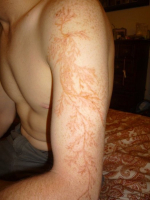
 |
Updated: 2019.10.10 ![]()
Ta•na"khꞋ specifies the time of year when Mōsh•ëhꞋ descended from Har Sin•aiꞋ with the two lūkh•ōtꞋ—and the textual evidence demonstrates that it happened during the winter rainy season with thunder and lightning;![]() opposite the late spring season of çÇâ äÇùÌÑÈáåÌòåÉú!
opposite the late spring season of çÇâ äÇùÌÑÈáåÌòåÉú!
 |
Corroborating the winter rainy season, the idolatrous “wild”![]() Egyptian
Egyptian Hât-HōrꞋ party (with A•ha•rōnꞋ wearing a gold cult-mask of Hât-HōrꞋ), which Mōsh•ëhꞋ encountered when he descended from Har Sin•aiꞋ with the two stone lūkh•ōtꞋ of the A•sërꞋët ha-Dᵊvâr•imꞋ, suggests a reversion to the idolatrous celebration of Egyptian goddess Hât-HōrꞋ’s annual “Festival of Drunkenness”, which fell around 10.01,![]() annually, on the Gregorian calendar—during the winter rainy season. Though she had a number of annual festivals, none fell around the time of Shâ•vū•ōtꞋ
annually, on the Gregorian calendar—during the winter rainy season. Though she had a number of annual festivals, none fell around the time of Shâ•vū•ōtꞋ
A fortiori, Tōr•âhꞋ-prohibited Dark Ages supernatural hokum aside, a lightning![]() bolt was the most plausible cause of the usually-temporary, radiating-beam patterning (Shᵊm•ōtꞋ 34.29, see photo) on Mōsh•ëhꞋ’s face; further strengthening the rainy winter months.
bolt was the most plausible cause of the usually-temporary, radiating-beam patterning (Shᵊm•ōtꞋ 34.29, see photo) on Mōsh•ëhꞋ’s face; further strengthening the rainy winter months.
On behalf of future generations of Yi•sᵊr•â•eilꞋ, é‑‑ä noted:
“But it isn’t with you
alone that I, Myself, carve-out this conditional bᵊrit offer, because it’s both for whomever is standing with us here today before é‑‑ä ël•ōh•eiꞋnū, and for whomever isn’t here with us today as well”
Time is an aspect of, and confined to, our physical universe; time cannot confine its Creator. For any given person, îÇúÌÇï úÌåÉøÈä may occur at any time of year. It isn’t limited to any specified time of year, nor even a given year, nor even a given millennium. From at least as early as the eiꞋrëv rav to Rut to every geir, îÇúÌÇï úÌåÉøÈä comes at whatever time of the year the individual person embraces the bᵊrit of Ta•na"khꞋ. This, of course, explains part of the theme: the connection between îÇúÌÇï úÌåÉøÈä and its emphasis on Rut and geir•imꞋ.
Aside from the three physical, agricultural, annual harvests, we are given the themes of Khag ha-Matz•ōtꞋ (the Yᵊtzi•âhꞋ) and Khag ha-Sūk•ōtꞋ (the Final Ingathering of nᵊphâsh•ōtꞋ). So we can interpolate what must be missing in-between the Yᵊtzi•âhꞋ and a still-future Final Ingathering of nᵊphâsh•ōtꞋ.
Christians and some fanatic or QaꞋbâlist Jews would mindlessly answer the mâ•shiꞋakh—but, without Tōr•âhꞋ (more specifically, Ta•na"khꞋ), there would be no concept of mâ•shiꞋakh. So the interim essential ingredient that must be commemorated by çÇâ äÇùÌÑÈáåÌòåÉú is, a priori, îÇúÌÇï úÌåÉøÈä.
“…and He fed you
with äÇîÈï, which neither you
nor your
forefathers had previously known about, in order for Him to inform you
that it isn’t by lëkhꞋëm alone that hâ-â•dâmꞋ yi•khᵊyëhꞋ, but, rather, by everything that issues from the Mouth of é‑‑ä shall hâ-â•dâmꞋ yi•khᵊyëhꞋ.”
Note that this metaphoric spiritualization of Tōr•âhꞋ was first raised by RibꞋi Yᵊhō•shūꞋa, obviously suprising and previously unknown to his rabbinic inquisitor (The Netzarim Reconstruction of Hebrew Matityahu—NHM![]() 4.1-4). This argument was initially rejected, and only subsequently adopted, by more recent rabbis.
4.1-4). This argument was initially rejected, and only subsequently adopted, by more recent rabbis.
The two lūkh•ōtꞋ of stone, the “bread of life” that Mōsh•ëhꞋ brought down from Har Sin•aiꞋ, is corroborated in çÇâ äÇùÌÑÈáåÌòåÉú by the two (leavened wheat, as contrasted to unleavened barley of Khag ha-Matz•ōtꞋ) lëkhꞋëm tᵊnūph•âhꞋ as Bi•kūr•imꞋ for çÇâ äÇùÌÑÈáåÌòåÉú. ![]()
Because of the double-portion of mân that Yi•sᵊr•â•eilꞋ was required to collect on Day6, for Sha•bâtꞋ, we place two khal•ōtꞋ on the Sha•bâtꞋ table.
But, additionally, this should remind us of the Two Lūkh•ōtꞋ Of Stone At Har Sin•aiꞋ, the True “Bread of Life”—thereby revitalizing our Bᵊrit with é‑‑ä every Sha•bâtꞋ!
No living mortal can see the ôÌÈðÄéí of é‑‑ä.![]() However, we’ve seen that lëkhꞋëm symbolizes the very Essence of é‑‑ä: His ôÌÈðÄéí! It is in this sense that we understand the LëkhꞋëm ôÌÈðÄéí and the Shū•lᵊkh•ânꞋ LëkhꞋëm ôÌÈðÄéí,
However, we’ve seen that lëkhꞋëm symbolizes the very Essence of é‑‑ä: His ôÌÈðÄéí! It is in this sense that we understand the LëkhꞋëm ôÌÈðÄéí and the Shū•lᵊkh•ânꞋ LëkhꞋëm ôÌÈðÄéí,![]() aka Shū•lᵊkh•ânꞋ äÇôÌÈðÄéí,
aka Shū•lᵊkh•ânꞋ äÇôÌÈðÄéí,![]()
Although declared in the context of the Mi•shᵊkânꞋ, Tōr•âhꞋ declares a mi•tzᵊwâhꞋ to provide LëkhꞋëm ôÌÈðÄéí on the Shū•lᵊkh•ânꞋ before Him perpetually.![]()
Obediently, today, in addition to commemorating the double-portion of mân collected on Day6, our weekly Shū•lᵊkh•ânꞋ Sha•bâtꞋ, with its two khal•ōtꞋ, commemorates the Shū•lᵊkh•ânꞋ LëkhꞋëm ôÌÈðÄéí and the continuing Bᵊrit between Yi•sᵊr•â•eilꞋ and é‑‑ä.
 |
 |